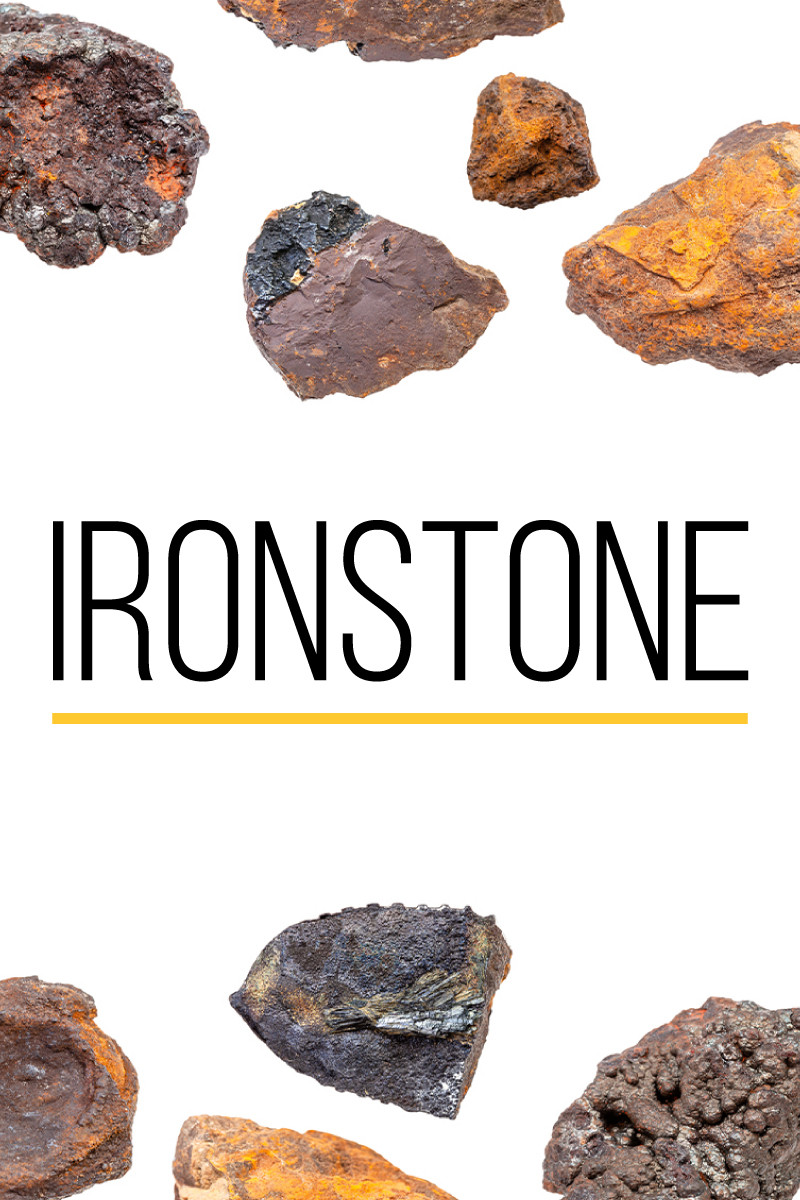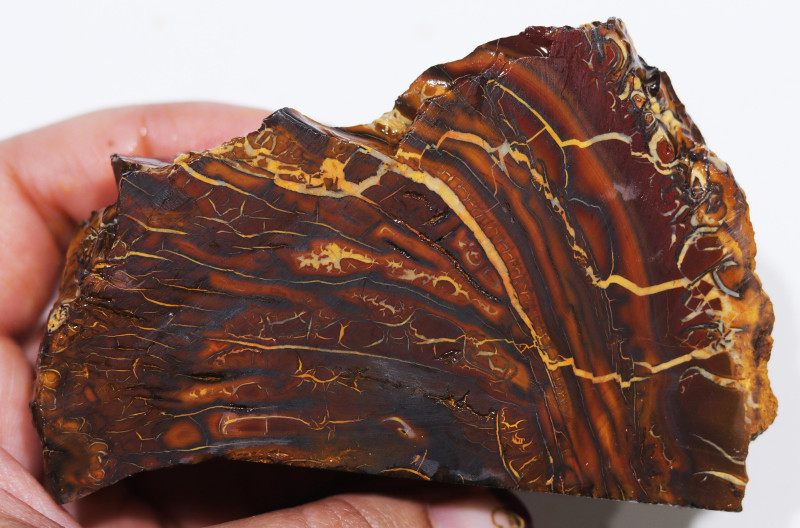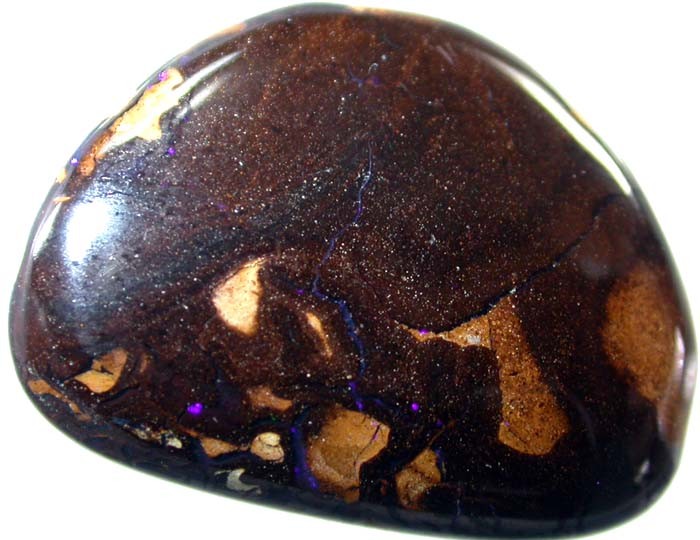
Ironstone Gemstone: Properties, Meanings, Value & More
 Ironstone is a sedimentary rock in shades of dark brown, light brown, and gray. While some varieties are pure ironstone, others are combined with opal, producing colorful hues like blue and green.
Ironstone is a sedimentary rock in shades of dark brown, light brown, and gray. While some varieties are pure ironstone, others are combined with opal, producing colorful hues like blue and green.
Picture a vast, sandy desert, with the scorching sun’s rays revealing all the gorgeous, rich tones of light and dark browns across the landscape.
While you can’t usually find the ironstone gemstone in the desert, the stone’s shades are reminiscent of the dry yet naturally beautiful tones of the Sahara.
If you’re looking to add more earthy tones and flavor to your home or personal style, ironstone is the rock for you.
Ironstone uses are varied, from industrial building exteriors to artisanal, rustic jewelry crafted by designers. Have you heard of ironstone dinnerware? As we said, ironstone is a dynamic material! After all, ironstone china is a well-known, gorgeous category of plate ware.
So what is an ironstone? Keep reading to find out everything about this earthy stone, including all the ironstone properties that are sure to entice you!

What is Ironstone?
Ironstone is a sedimentary rock that mainly appears in brown shades. It’s certainly not a precious gemstone, though some opal-ironstone varieties are considered semi-precious gemstones.
While ironstone isn’t a zodiac stone for any particular sign, lucky Libras and Scorpios can use it as an alternative October birthstone to the traditional opal or tourmaline.
So, what type of rock is ironstone? Ironstone is a sedimentary rock, but to understand what that means, we’ll need to understand ironstone formation.
Ironstone Origins & Sources
You might remember the three main rock types being drilled into your noggin in third- grade science class, but if you need a refresher, they are igneous (volcanic), sedimentary, and metamorphic.
Ironstone geology specialists tell us the stone is a sedimentary rock. Sedimentary rocks are formed close to the Earth’s surface (often above it) instead of below the Earth’s surface like metamorphic and igneous rocks. Many organic processes contribute to sedimentary rock formation, including erosion, weathering, dissolution, precipitation, and lithification.
Erosion and weathering break down large rocks, even entire mountains, into sand or mud, called sediment. After that, dissolution wears away the sediment with acidic water.
Ironstone then forms through precipitation and lithification. Sediments like clay and sand slowly form into rocks with water, creating the signature layered ironstone texture that forms atop other sediments.
Now that we know the soil from which ironstone forms, we can better understand its mineral characteristics and usages for gemstones and jewelry.
Mineral Characteristics
Sedimentary rocks are hardened sediments like sand and mud. Consequently, ironstone ranks low on the Mohs mineral hardness scale: between 5 and 5.5. Opals also rank relatively low on the scale, at 5-6.5, meaning both are easily scratched by orthoclase (feldspar).
Mineral-wise, ironstone contains about 15% iron that comes from minerals like goethite, siderite, and berthierine within ironstone. You might also find macrofossils, quartz grains, and ooliths (rounded grains of oolite) within ironstone.
For such an earthy opaque stone, ironstone boasts impressive pleochroism and color streaks. They often display flashes of light brown, orange-yellow, and even red. Let’s go deeper into the ironstone mine and dig up the stone’s specifications.

Ironstone Specifications & Characteristics
Color: Light and dark brown, sometimes with flashes of blue and green if mixed with opal
Crystal structure: Orthorhombic
Transparency: Opaque
Fracture: Uneven
Streak: Light brown, orange, red
Pleochroism: Brownish to orange-yellow
Let’s move on to explore the metaphysical side of ironstone meaning and properties.
Ironstone Meaning
First off, why is it called ironstone? Ironstone has etymological roots in many cultures. Iron comes from the Greek word ieros and the Middle English word yron, both of which means “strong.” Stone comes from the Proto-Germanic word stainaz, referring to all rocks and precious gemstones.
Fun fact: The word stone was a common synonym for “testicle” in Old English. In other words: ironstone is the name for a strong “stone.”
Now that we understand the literal meaning of ironstone, let’s look at what ironstone means for our health and wellbeing.
Ironstone Healing Properties
Ironstone isn’t just any rock. Like many other gemstones, ironstone is a healing stone that offers great mental and physical health benefits.
A predominantly brown gemstone, ironstone’s color promotes relaxation, connection with the earth, and reduced stress. But that’s not all — let’s dive into all the ironstone healing properties, starting with the stone’s physical benefits.
Physical Healing
Those nearing their 50s reach a higher risk for muscle atrophy (muscle thinning and weakness). In fact, everyone is destined for muscle atrophy by the time they hit 75. It’s simply a symptom of aging.
Thinning muscles might make you feel physically unbalanced, weaker in one limb than the other, or unable to be as physically active as you once were.
While doctors recommend physical therapy, dietary changes, and in some cases, surgery, you might consider keeping ironstone close to your heart as well. Crystal healers purport that one of the greatest ironstone uses is soothing symptoms of muscle atrophy. It’s a great good luck charm to have in addition to any other treatments your doctor recommends.
Ironstone may also help soothe symptoms of:
Sore throat
Gall and kidney stones
Internal bleeding
Blood disorders
While ironstone can make your body more durable, it also has emotional benefits to heal internal emotional strains.

Emotional Healing
You can experience a range of emotions — that’s part of being human. While the positives of our emotions include the ability to feel love, happiness, and surprise, we can also experience the negatives of our emotions.
Life experiences may cause you to feel angry, sad, scared, and even disgusted. And, certain events cause emotional stress — be it the death of a loved one, heartbreak, a new job — you name it.
So, emotionally, what is ironstone used for?
Ironstone can bring you comfort and tranquility, especially during times of immense stress. The stone is known to provide emotional and mental balance, keeping you level-headed amidst life’s countless tribulations.
Feeling stressed might also make you cling to old beliefs, traditions, and values, even if they’re not especially helpful to the situation. The past is comforting, but nothing grows in our comfort zone!
Ironstone is said to help us embrace new ways of thinking and ideas, allowing us to let go of old traditions that hold us back. Embracing new ideas helps you open your mind to other perspectives, granting a better sense of diplomacy that will help you in your relationships.
Speaking of open minds, what chakra does ironstone open?

Chakra Healing
The chakras are your body’s seven energy centers, thought to promote healthy emotional and physical well-being when open. If your chakras are blocked, you might experience a range of physical and emotional symptoms.
Considering ironstone’s down-to-earth vibe, it makes sense that this gemstone opens up your root chakra. You might also use the Sanskrit name for the root chakra: Mūlādhāra, which translates directly to “root.”
Your root chakra connects you with Mother Nature herself, helping you feel stable, secure, and grounded.
Do you ever feel insecure about your finances?
Confused about where to call home?
Running from one place (or even person) to another in search of emotional security?
These are some of the effects of a blocked root chakra.
As this chakra sits at the base of your spine, you might be able to guess what the physical symptoms of a blocked root chakra might be: constipation, pelvic pain, and incontinence.
If you’re feeling any of the above, your root chakra is begging for a release! Ironstone rock is known to release blockages here. Once free-flowing and open, your root chakra will help you feel sure of yourself and grounded.
Like ironstone, dark or black gemstones tend to open up the root chakra, like black obsidian, black tourmaline, and smoky quartz.

Ironstone History
Ironstone is estimated to be the same age as many other sedimentary rocks (billions of years old), though its exact age is still a mystery. The first noted discovery was much later, in the mid-1800s. Cleveland miner John Vaughan and mining engineer John Marley discovered the stone along the coast of Lake Michigan.
Most ironstone was used for industrial and commercial purposes, produced with steel for commercial equipment and building exterior material.
Remember how we mentioned ironstone china? This china received its name for its strength and durability, usually uncharacteristic of china and delicate dinnerware. And its iron content? Zero.
Make no mistake, ironstone china doesn’t have any iron in it, and it’s not made from the ironstone that we discuss in this article!
So, where is ironstone rock found?

Ironstone Mining Locations
Like many of the world’s top-quality gemstones, ironstone is found primarily in Australia — specifically in the Australian Outback. These regions are large and sparsely populated, with little precipitation. In other words: dry, isolated desert.
Outback Australia has some of the biggest opal mines where one can find ironstone as well:
Koroit, in western Victoria
Yowah, in Queensland
Jundah, also in Queensland
Each area boasts some of the more expensive ironstone-opal varieties. For example, Jundah is a source of the boulder opal, an opal variety with an ironstone backing as a kind of natural opal doublet.
Koroit is known for the high-value ironstone matrix opal, which shows gorgeous blue, green, and purple play-of-color. In Yowah, miners source a precious Yowah Opal Nut — an opal that doesn’t contain ironstone, but that’s found within ironstone deposits.
Some miners have also found ironstone attached to quartz reefs with gold — but does ironstone contain gold? Some Australian miners have found pieces of gold completely enveloped in ironstone, but it’s not common.
You can also find ironstone in the US, Russia, and, for the tiger iron stone, South Africa.
With so many wonderful varieties, you might wonder: is ironstone valuable?

Ironstone Price & Value
So, how much is ironstone worth? The answer depends on the individual specimen. Usually, ironstone is pretty affordable — but that depends on the cut and color.
Cut
Ironstone is often sold as rough specimens. But, some lapidaries (gem-cutters) fashion them into smooth cabochon gemstones and solid, silky beads.
Smooth opal-ironstone cabochons range between $13-$280 per carat. Ironstone rough ranges between $1-$10 per carat, while beaded ironstone tends to go for even less, at $1-$30 per carat.
Another factor influencing ironstone price is color.
Color
Ironstone primarily shows shades of dark and light brown. However, some varieties display stunning pleochroism that boosts up the value.
For example, you might find an expensive ironstone specimen that’s banded with red and black flashes of color. This variety is known as tiger iron, and it's a popular choice for ironstone jewelry. Tiger iron stone's meaning and healing properties are consistent with regular ironstone, which means you can soak up all the same benefits!
Opal ironstone varieties are also more expensive but look lovely in a pendant, ring, or even home décor!
Are you looking to open your root chakra and add earthy tones to your style on a budget? Why not rock an ironstone rough specimen for an earthy aesthetic? They’re more affordable and offer a rustic, natural look to compliment your style.
Now that you have the 411 on ironstone price, it’s time to pick out the perfect piece!

Ready to Look Iconic with Ironstone?
Ironstone is often seen as a rock more than a gemstone material, but that doesn’t mean its beauty and benefits are any less powerful than traditional crystals.
Opal and ironstone blends shine with divine flashes of color, and raw ironstone specimens bring you stability. The options with ironstone gems are lovely and endless, so you’ll relish in all this stone has to offer!
Search the Gemstone Encyclopedia
Related Auctions
Related Articles
Originally the Birthstones or gemstones were associated with a zodiac sign or the month of a individuals birth. Find out what your stone is and view the stones we have for sale
8th Feb 2021
There are dozens of quartz and chalcedony gems with various colors and patterns. Learn all about quartz properties and every type of quartz, from amethyst and agate to plasma and phantom quartz!
15th Oct 2020
Hackmanite is a pink to violet sodalite gem known for its unique color-change and luminescence. Learn why hackmanite is special, from its rare qualities to the types of hackmanite jewelry available.
28th Mar 2018
Latest Articles
Yugawaralite is a rare colorless, white, or pinkish zeolite crystal named for its discovery in Yugawara, Japan. Here we uncover the multifaceted history, properties, prices, and uses of yugawaralite.
24th Mar 2025
Simpsonite is a lesser-known mineral known on the gem market for its durability, yellow-orange color, and rarity. Discover all the properties, uses, prices, and history of simpsonite.
3rd Mar 2025
Kurnakovite is a colorless crystal related to inderite and rarely faceted but known among collectors. Explore the mineral traits, history, prices, and more in this kurnakovite guide.
17th Feb 2025
Article Categories
How To's is where you will find helpful articles from gem Rock Auctions on how to cut gemstones, select gemstones and buy gemstones.
9 Articles



![IRONSTONE BOULDER WHALE TAIL CARVING 58 CTS [MGW1482 ]](https://liveplatforms-production.b-cdn.net/tenants/gr/uploads/images/40000-44999/40327/40327_1.jpg?width=480&aspect_ratio=1001%3A1000)
![IRONSTONE BOULDER WHALE TAIL CARVING 58 CTS [MGW1477 ]](https://liveplatforms-production.b-cdn.net/tenants/gr/uploads/images/40000-44999/40277/40277_2.jpg?width=480&aspect_ratio=1001%3A1000)
![IRONSTONE BOULDER WHALE TAIL CARVING 60 CTS [MGW1474 ]](https://liveplatforms-production.b-cdn.net/tenants/gr/uploads/images/40000-44999/40274/40274_2.jpg?width=480&aspect_ratio=1001%3A1000)
![IRONSTONE BOULDER WHALE TAIL CARVING 65 CTS [MGW1472 ]](https://liveplatforms-production.b-cdn.net/tenants/gr/uploads/images/40000-44999/40272/40272_2.jpg?width=480&aspect_ratio=1001%3A1000)